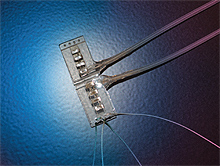Advanced Platform Technology Center
New Technologies for Communicating with Peripheral Nerves
 Effectively exchanging information with the peripheral nervous system is important for many advanced therapeutic and prosthetic applications of neurotechnology. Activating fascicles within or detecting the natural activity of sensory or motor nerves requires intimate contact between recording or stimulating electrodes and the target neural structure.
Effectively exchanging information with the peripheral nervous system is important for many advanced therapeutic and prosthetic applications of neurotechnology. Activating fascicles within or detecting the natural activity of sensory or motor nerves requires intimate contact between recording or stimulating electrodes and the target neural structure.
Peripheral nerve cuff electrodes should achieve this while being as small and flexible as possible to match the compliance of the nerve and minimize the potential of neural injury or tissue damage. APT Center Investigators have developed and tested a new electrode with regionally patterned stiffness to direct the reshaping the nerve’s cross section for improved selectivity. It is compatible with microfabrication techniques, and is significantly smaller and more flexible than prior designs to allow it to bend and move with the nerve.
The nerve cuff has a multi-layer structure consisting of thin, narrow pieces of a stiff, biocompatible polymer sandwiched between thin, flexible silicone sheets. The embedded polymer bars are compatible with metal deposition microfabrication techniques, allowing for a high number of densely spaced contacts. In bench tests, the cuff maintained a diameter greater than required by industry standards for ensuring adequate blood flow and preventing neural injury. Animal tests confirmed that the new design is biocompatible and results in no appreciable changes to the nerve structure or function, even when placed in tight anatomical locations near the joints. Nerves with cuffs remained healthy and conducted impulses normally after months of implantation. Stimulation thresholds were stable over time and consistent with other nerve cuffs. Future plans are to use this new neural interface in both upper and lower extremity applications for restoring natural sensation to amputees and standing, stepping and arm movements to individuals with paralysis.
Principal Investigators: Ronald Triolo, Ph.D. • Dustin Tyler, Ph.D.
Clinical Collaborators: James Anderson, M.D. • Harry Hoyen, M.D. • Gilles Pinault, M.D.
Funding Agencies: National Institutes of Health; Veterans’ Affairs Rehabilitation Research and Development




















